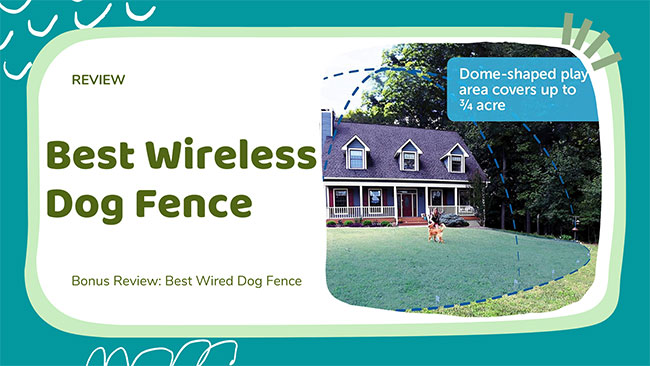
best wireless dog fence 2022- Dogs are adventurous animals; it’s literally in their nature to want to explore beyond the boundaries of our homes and properties. Sometimes they will chase squirrels, throw tennis balls, and even your kid’s school bus if given enough slack.
So, how do you keep your dog inside a safe, predetermined boundary?
The answer is simple—get a dog fence!
I want to give you a complete guide to understand all there is to know about traditional, wired and wireless fences.
We’ll also include a review of the best wireless dog fence, wireless dog fence reviews (as stated by customers), and the best electric fence for dogs.
We hope you find this guide useful when you are thinking about keeping your buddy in safe territory.
So, let’s jump into the review section first!
best wireless dog fence in 2022
There are various electrical fences on the market – both wired and wireless. I have found the best wireless dog fences with the most wireless dog fence reviews and researched them in detail so that you can save time in choosing the best available option for both you and your dog.
When it comes to wireless fence systems, PetSafe ranks as one of the highest sought out brands in the market. Depending on their houses, they have a wide range of products suitable for various owners.
#1. PetSafe Wireless Pet Containment System – (PIF-300)

PetSafe Wireless Containment has been widely tested and met dogs’ safety and health checks. It has an easy to set-up system and covers a range of ½ acres (180 feet). It’s one of the highest selling products on Amazon with the most wireless dog fence reviews with a very good rating. This is, in fact, one of the best electric fences for dogs!
Key Features:
Adjustable Circular Perimeter:
The unit emits a 17.5 radio signal in a circular pattern which is completely adjustable. It has a 90 ft. perimeter radius in all directions. The transmitter can move to give your dog access to the front and back or any one of your choice.
Easy Installation:
You don’t need to dig or use any wires. However, you need to adjust the transmitter to measure the range.
Adjust Shock Levels:
There are five different corrective shock options to choose from. Bigger dogs may need higher levels.
Waterproof:
The collar on your dog is waterproof; it will not be damaged in the rain.
Auto Shut-Off:
If your dog leaves the boundary zone, the collar unit will turn off automatically after 30 seconds. It will activate again after 5 minutes.
Connect Multiple Yards:
Join transmitters with your neighboring yard to give them more space for your pets.
Portable System:
Set up anywhere. Easy dismantling option.
Multiple Pets:
The pet containment system can be used with multiple pets—you just have to buy additional collars.
8 Pounds & Higher: This unit is best suited for pets with a minimum weight of 8 lbs.
Pros:
- No digging, no wires
- Portable
- Adjustable diameter
- Training guide included
Cons:
- The fence is only circular and cannot be regulated
- Not suitable for small or odd-shaped yards
- Some customers complained that the boundary lines are inconsistent
Check the latest price on Chewy
#2. PetSafe Stay + Play Wireless Fence – (PIF00-12917)

With very similar features to the PIF-300 (see above), the Stay + Play is another superb product by PetSafe. It’s also wireless and has a decent range of ¾ acres. You can set it up anywhere, not just in your home. Major differences with the PIF-300 are a rechargeable collar unit (the previous ones used batteries) and a “tone only” function with no static shock. With a lot more features, it stands as the second-best invisible dog fence on our list.
Key Features:
Wireless & Easy:
No wires and no digging required. Just turn on the transmitter and adjust your range.
More Space:
The unit covers a ¾ acre circular area (210 feet).
Adjustable Shock Levels:
Five different corrective levels are available. There is also a “tone only” option.
Waterproof:
The waterproof collar will work even if your dog plays in the rain.
Auto Shut-Off:
If your dog leaves the boundary zone, the collar unit will turn off automatically after 15 seconds.
Connect Multiple Yards:
If you have a friendly neighbor, you can join transmitters to give them more space for your pets.
Portable System:
The unit is portable, and if you move from the area, you can just pack it up and leave.
Suitable For Smaller Dogs:
This unit can be used with small dogs—even dogs from 5 lbs. and up.
This is certainly one of the Best Invisible Dog Fences.
Pros:
- Compatible with the original PIF-300 unit
- Both units work simultaneously
Cons:
- Less stable than the original PIF-300 unit
- Some customers complained of their units having difficulty working in uneven terrains
Check the latest price on Chewy
#3. PetSafe Free To Roam Wireless Fence

Another excellent wireless product from PetSafe has a newer design and has great features, which are a bargain at the price range. It has a range of ½ acres, and the distance is adjustable. This unit comes with two extra battery packs free of charge with great connection and range.
Key Features:
Wireless Freedom:
No wires, No digging, No fuss.
More Space:
The unit covers a ½ acre circular area (210 feet)
Adjustable Shock Levels:
Adjustable 5 level shock collar including a “tone-only” option.
Waterproof:
Certified to be safe, even wet.
Portable System:
Superb portability option.
No Weight Limitations:
Can handle dogs of all weights.
Pros:
- Durable
- Water-resistant
Cons:
- Short replacement battery life
- Expensive
Check the latest price on Chewy
Best Wired Dog Fence in 2022
#1. eXtreme Dog G2 In-ground Fence

The eXtreme dog has been a forerunner in the field of electric fence systems, and their G2 in-ground fence has been a long-time Amazon bestseller. They include many perks with the added benefits of an in-ground fence.
With a coverage area from 500 to 5000 feet, coving an area of 10 acres, the G2 can be customized to any property. The wiring they provide is of the highest 14-gauge quality wiring available in the industry. The wire itself is waterproof and professional-grade twisted, which will last you a long time.
It also comes with a surge protection kit, waterproof splices, and other essential installation materials.
Pros:
- Premium Materials
- Adjustable Shock Levels
- Large Coverage Area
- Waterproof and Heavy-Duty
- Long-Lasting Battery
- Value For Money
Cons:
- Heavy Wiring
- DIY installation can be a hassle
Check the latest price on Chewy
#2. PetSafe Yardmax In-ground Fence

PetSafe is already an established company in the world of wireless electric fences, but their in-ground products are also superb. They are one of the dominant brands that rule pet fencing systems, and their PetSafe Yardmax proves it.
With a range of 1/3 acres, PetSafe uses 20 gauge wiring in their products. The shock collar can be a little stiff while adjusting, but it has both the warning tone and static shock feature. Although the wiring included can be short for large properties, it is still an excellent choice for dog owners with an odd-shaped yard.
Pros:
- No shock on re-entry
- Made from durable materials
- Wiring doesn’t have to be deep in the ground
Cons:
- Light gauge wire
- Not portable
Check the latest price on Chewy
#3. SportDOG In-ground Electrical Fence SDF-100A

SportDOG is another established brand when it comes to manufacturing dog GPS products and other dog tech products. They have entered the in-ground fence market with products that are quickly becoming customer favorites. Their SDF-100A is one of the best-rated products on Amazon.
SportDog includes 1000 ft of 18 gauge high-quality wiring with the SDF-100A, which is surge protected. It covers 2/3rd to a whole acre. It’s a great product for dogs weighing over 10 lbs.
Their 4-level static shock dog collar is more than capable of handling dogs with any temperament. You won’t have to worry about rain as the collar is also waterproof.
Pros:
- Durable wiring
- DIY installation
- Long wiring
- Waterproof
- Surge-protection
Cons:
- Redoing can be a hassle due to the strength of the wiring
- Some customers have complained about the collar being ephemeral
Check the latest price on Chewy
What are Dog Fences?
Before setting up a proper boundary for your dog, you have to first understand: what are pet fences and how do they work?
A pet fence is an electronic system designed to keep a pet (or other domestic animals) within a set of predefined boundaries.
The boundary is also sometimes dubbed “fenceless” as it has no physical barrier. Whenever your pet crosses the boundary line, a shock is delivered via an electric collar, thus discouraging the pet from crossing.
In 1973, the system was invented and patented by Richard Peck. The patent remained with Invisible Fence Co, now known as Invisible Fence Inc. through until 1990.
Types of Electric Dog Fences: In-Ground vs. Portable Wireless
When it comes to electric dog fences, there are two types available: wireless and underground. Both have their own set of advantages and disadvantages.
The variant you buy will depend on your living area, type of yard, and how much access you want your dog to have.
#1. Wireless Electric Dog Fence
Wireless Fences use GPS and radio signals to set a boundary perimeter for your dog. The collar from the dog communicates with the main unit, which is placed inside the house. Whenever the collar goes beyond the set perimeter, it sends a mild shock to ensure that dog does not travel outside.
Advantages:
- Units are portable (but may vary in some cases)
- No wires
- No digging
- Easy installation
- The perimeter can be adjusted according to the user’s needs
Disadvantages:
- Boundaries are always circular
- Signals can sometimes fluctuate
- Some units interfere with other radio signals
#2. Wired Underground Fence
Wired underground fences are another variant of invisible fences. The fence is the string of wire that’s dug into the perimeter of the yard and connected to the main unit. There is a similar collar that mildly shocks the dog whenever the wired boundary is crossed.
Advantages:
- The perimeter can be customized according to your needs
- It can be used to create restricted zones within the perimeter
- No fluctuations
Disadvantages:
- Complex installation and may require professional help.
- The unit is not portable.
- A path must be dug around the yard.
- Repairs are annoying and time-consuming.
Why Are Electric Dog Fences Better Than Traditional Fence?
While standard fences look nice, many owners prefer an electric fence to keep their dogs and pets from crossing the perimeter.
Here are a few reasons you should consider buying an electric fence:
- Easy Maintenance: It is much easier to maintain an electrical fence than a traditional fence. Traditional fences are usually made of wood or wire mesh which requires regular care.
- Less Expensive: Installing a physical fence around your yard will put a dent in your savings, while electric fences only take a small fraction of that amount.
- Provides Great Views: A physical fence blocks your view, while an electrical fence will never impede a great view of the surroundings.
- A Safer Alternative: Dogs can easily damage, breakthrough, or dig under any physical fence; however, with electric fences, users will not face such trouble.
Safety Issues Regarding Electric Fences
Despite popular opinions, electric fences are quite safe. They are not cruel to the pets and frightening as some people might imagine.
The shock emitted from the collar is static, which means it causes irritation rather than a hurtful jolt. That is why it’s called a corrective shock.
It is similar to what you’d experience when you touch a metal handle or rub your socks on a rug.
Your pet will not be injured or hurt in any way. It’s designed to “surprise” the dog rather than cause pain.
Countless pet professionals and vets around the world recommend wireless and in-ground fences; they are safe.
They are smart-built and provide an easy way to control where your pet roams around on the property.
Training Your Dog With An Electric Fence
All the negative wireless dog fence reviews and electric fence for dogs reviews you hear come from users who didn’t properly train their dogs. Letting your dog roam around after setting up the electric fence is a really bad idea.
Your dog WILL NOT figure it out on its own. They have no understanding of WHY they are being shocked when they are attempting to go to an area that was previously accessible.
In some cases, dogs become frightened and will stay immobilized in the yard, too terrified to even move.
They might also not go out of the house. In extreme cases, they might act irrational and lash out.
That’s why training your dog to understand the whole point of electric fences carries such importance.
The reason the fence is used is to restrict the dog within a certain perimeter, not to terrify them into paralyzation.
How To Train Your Dog With An Electric Fence?
You will be given a manual on how to train your dog when you purchase an invisible fence; however, they don’t carry enough details to implement proper training.
Here are a few things you need to do to train your dog.
#1. Flags:
First, finish setting up the dog fence system. When it’s up and running, place flags around the perimeter of your safe area; the flags should be placed 10 feet apart.
#2. Teach The Dog with Tone Only:
Take the collar and set it to only play the tone. Hold the collar in one hand and the dog’s leash in the other.
Approach the boundary line and whenever it starts beeping, bring your dog towards the safety area.
Repeat this process until he resists you when walking toward the flag.
#3. Add Static Shocks:
When your dog understands the flags, add a static shock in the training menu. Start with a slow setting and adjust whenever required. Continue to approach the flags until he resists.
#4. Distraction Tests:
It’s essential that you test your dog after a few days of training. You can do that by throwing a ball or toy across the electrical fence and seeing if he follows through.
#5. Off-Leash Training:
After 14 days of solid training, let your dog go “leash-free” into the yard. Observe him for a while.
Do not attempt this step before completing the previously recommended steps.
#6. Remove Flags:
After sufficient training (approximately three weeks), start removing the boundary flags. Keep an eye out for your dog—if he acts agitated, reassure him with pats and go back a few steps and start again.
Dogs are smart, and they will eventually learn if you teach them properly. In time, you can remove all flags to be left with only an invisible fence.
Extra Training Tips
Short Training Sessions:
It’s more effective if you keep your training sessions short; this way, it won’t make your dog frustrated or exhausted. Short, multiple 10-15 sessions are the way to go!
Fun Before Training:
Start your training sessions with lots of fun. Take plenty of breaks and stop if your dog seems stressed. Be patient!
Changing Collars:
Be sure to change your dog’s electrical fence collar before taking him out for a walk. It’s better to take the same route when leaving the house—it will not confuse the dog.



